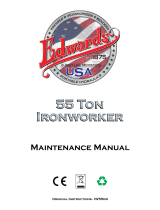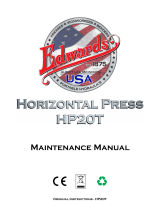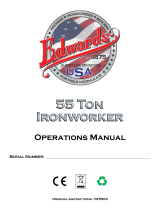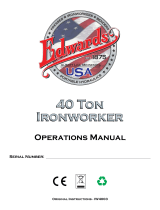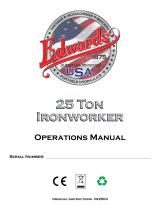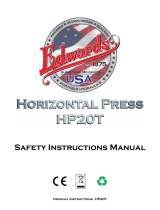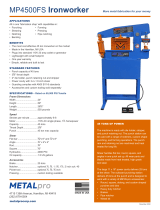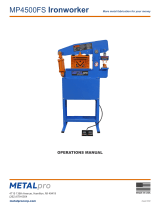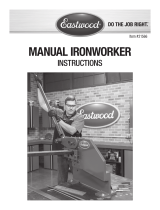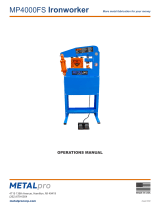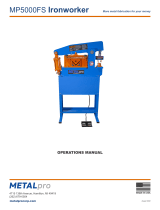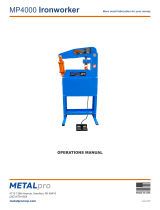Page is loading ...

Maintenance Manual
Original Instructions - IW100DX04

1
1 General
Operator and Supervisor Information
Signal Word Denition
Signal Word Panel
2 Maintenance Precautions
Maintenance Schedule
4 Punch
Punch and Die Operating Clearances
Punch Tonnage Requirements
6 Bar Shear
Remove and replace stationary blade
Remove and replace moving blade
7 Angle Shear
Remove and replace stationary blade
Remove and replace moving blade
8 Notcher Station
(50/60/65/75/100dx/120 Ton Ironworkers)
Remove and replace moving blade
Remove and replace stationary blade
9 Pedestal Die
Punch and Die Operating Clearances
Punch Tonnage Requirements
Optional Tooling Maintenance
10 Notcher (25/40/55/100Ton)
Remove and replace moving blade
Remove and replace stationary blade
11 Angle Notcher
Remove and replace moving blade
Remove and replace stationary blade
12 Oversize Punch
Punch and Die Operating Clearances
Punch Size Tolerances
13 Pipe Notcher
Remove and replace moving blade
Remove and replace stationary blade
14 Brake Tooling
Remove and replace moving punch
Remove and replace stationary 4-way die
15 Rod Shear/Multi-Shear
Remove and replace moving blade
Remove and replace stationary blade
16 241 Punch Tooling
Punch and Die Operating Clearances
Punch Tonnage Requirements
Maintenance Manual Table of Contents Operator and Supervisor Information
This is one of four manuals supplied with your machine.
• Installation Manual
• Safety Instructions Manual
• Operations Manual
• Maintenance Manual
READ ALL MANUALS BEFORE OPERATING MACHINERY. Operating
machinery before reading and understanding the contents of all four
manuals greatly increases the risk of injury.
Each of the four machine manuals describe ‘best practices’ in handling,
installing, operating and maintaining your machine. The contents of
each manual is subject to change without notice due to improvements
in the machinery or changes in National or International standards.
All rights reserved. Reproduction of this manual in any form, in whole or
in part, is not permitted without the written consent of Edwards Manu-
facturing Company.
Keep all manuals close to the machine to allow for easy reference when
necessary.
Provide operators with sufcient training and education in the basic
functions of the machine prior to machine operation.
Do not allow for operation of the machine by unqualied personnel. Ed-
wards Manufacturing Company is not liable for accidents arising from
unskilled, untrained operation.
Do not modify or change the machine without written authorization from
Edwards Manufacturing Company. Unauthorized modication to a ma-
chine may result in serious operator injury, machine damage and will
void your machine warranty.
Never leave a powered machine unattended. Turn machinery OFF be-
fore walking away.
This machine is manufactured for use by able bodied and able minded
operators only. Never operate machinery when tired or under the inu-
ence of drugs or alcohol.
Do not resell, relocate or export to a destination other than to the original
point of sale. Edwards has designed this machine to meet the stan-
dards of the original receiving country and is not liable for meeting any
governing body or performance standards beyond those of the original
receiving country.
Signal Word Definition
Indicates a hazardous situation that, if not avoided,
will result in death or serious injury.
Indicates a hazardous situation that, if not avoided,
could result in death or serious injury.
Indicates a hazardous situation that, if not avoided,
could result in mild or moderate injury.
Indicates information considered important, but not
hazard related.
Signal Word Panel on Machine
Critical machine safety information is identied on signal word labels.
Labels are attached adjacent to the potentially hazardous locations of the
machine. Reference the Safety Instruction Manual for additional informa-
tion regarding the potentially hazardous condition identied on the label.
Review ALL labels on the machinery, reference the operational pre-
cautions and safe operations sections within this manual before any
operation activity is initiated.
Failure to read and understand the signal word labels afxed to the
machinery may result in operator death or injury.

2 3
Reasonable, common sense safety precautions should be observed
when maintaining the Ironworker or hydraulic accessory tool. The fol-
lowing precautions are described in order of their hazard.
Electrical Hazard
Dangerous high voltages are present inside the electrical enclosure
of this product. Only qualied, authorized, maintenance or service
personnel should gain access to the electrical panel.
Lockout Power
Danger, circuits are live. Lockout / tagout upstream power source
before any maintenance activity is performed.
Shear / Crush Hazard
Moving parts can cut and crush. Keep hands clear when servicing
and maintaining the Ironworker.
Hydraulic Fluid Hazard
Hydraulic hoses are under pressure. Pressurized uid can pierce
skin and cause severe injury. To avoid physical hazard, always wear
personal protective equipment when servicing / maintaining the
Ironworker.
Do Not Operate With Guard Removed
Physical barriers and guards have been designed and installed to
protect the operator/maintenance personnel from moving parts
that can pinch, cut and crush. If it is necessary to remove guarding
when servicing the Ironworker, immediately replace guards after ser
vice and prior to power being restored to the machinery.
Refer to Manuals
For safe installation, operation and maintenance of the machine,
read:
Installation Manual
Safety Instructions Manual
Operations Manual
Maintenance Manual
Wear Personal Protective Equipment
To avoid physical hazard wear protective eyewear, clothing, gloves,
footwear, head-gear and hearing protection.
Slipping, Tripping and Falling
During routine maintenance hydraulic uid could spill outside of the
machine footprint. Plug hose ends when working with hydraulic
uids and clean up spills near the machinery in a timely manner.
Your Edwards Ironworker will benet from reasonable care and
periodic maintenance. Reasonable care includes daily visual
observation, general maintenance daily, weekly, monthly and at
hourly milestone intervals by operator/maintenance personnel.
Perform inspections and maintenance of the electrical, hydrau-
lic, and mechanical systems of the Ironworker and any optional
Edwards hydraulic accessory connected to the Ironworker as
follows:
Daily/Shift Change Visual Observation
Electrical System
Visually inspect incoming power and exposed surface conduit or cabling
on the Ironworker for signs of damage. Cut, abraded or crushed electrical
cords may present an electrical hazard to the Operator and damage the
machinery. Replace fuses as necessary with same type and rating.
See Figure 1 below.
Hydraulic System
Visually inspect exposed or surface mounted hydraulic hoses and t-
tings for signs of damage. Cut, abraded or crushed hydraulic hoses or
leaking ttings may present a hydraulic uid hazard to the Operator
and damage the machinery.
Plug hose ends when working with hydraulic uids and clean up spills
near the machinery in a timely manner to reduce the likelihood of
spills, trips and falls.
Mechanical System
Visually inspect guards and material hold-downs protecting moving
parts. Guards and material hold-downs must remain on the machine
for safe operation. Clear any material obstructions at the work stations
prior to visually inspecting moving parts of the machine. Cycle the
machine. Machine should operate smoothly in hydraulic extend and
retract mode.
Observe mechanical operating clearances. Punches, dies, angle shear,
notcher and bar shear blades should be evenly gapped and free of
nicks, chips or burrs in their surface.
Ironworker operation creates small concussive shocks and vibration
that may loosen hardware and fasteners over time. Inspect fasteners
and ttings and tighten where loose.
Maintenance Precautions Maintenance Schedule
Failure of any element of the daily/shift change visual obser-
vation will require maintenance of the affected Ironworker or
accessory componentry. Please follow the following mainte-
nance procedures.
General Maintenance - Daily
Lockout power to machine.
Clean your Ironworker daily with a compressed air nozzle and
soft cloth lighly moistened with a mild, water based detergent
solution. Remove lings, dirt, dust and grime and excess lubricant
from working surfaces. All clean surfaces must be fully dry before
powering up machine.
Grease all machine guides and pins supplied with a GREASE
DAILY designation with NLGI Grade 2 (NLGI Service GC-LB) or
equivalent premium, heavy duty lubricant.
General Maintenance - Weekly
Lockout power to machine.
Check blade tolerance. Maintain .010 clearance between xed and
movable shear blades on 40, 50, 55, 60 and 65 Ton models at all
times. Maintain .015 clearance between xed and movable shear
blades on 75, 100, 100D, 120 Ton. 110 Elite and 110/65 DO Elite
models at all times. Insert a feeler gauge between xed and mov-
able blades to verify proper blade clearance and shear tolerance.
Adjust tolerance of shear blades by relieving the locking nuts that
secure the gib-pins to the Ironworker frame. Once loose, rotate gib-
pins to push the operating center against the frame. Gap the angle
and bar shear blades with the specied clearance and tighten the
gib-pin lock nuts. Failure to maintain proper clearance will result in
lower quality cuts, damage to blade, blade pockets and the poten-
tial to damage the Ironworker frame.
General Maintenance - Monthly
Lockout power to machine.
Check gib-pins for lubrication and snugness to the operating cen-
ter. Tighten gib-pins and locking nuts to maintain blade clearance
as indicated above. Gib-pins are wearing parts. Order replacement
gib-pins through your Edwards Distributor or through Edwards Mfg.
Co.
Check the ISO Viscosity 46 hydraulic uid level monthly. maintain
the correct volume of hydraulic uid in the reservoir as indicated.
Contaminated uid will compromise your cutting operation.
General Maintenance - First 30 Hours
Lockout power to machine.
Replace the oil lter on your Ironworker after your rst 30 hours of
use. External oil lters are available through your Edwards Distribu-
tor or Edwards Manufacturing.
When working on the hydraulic power plant use plugs to cap hose
ends during maintenance procedures to minimize uid loss. Clean
up spills near the machinery to reduce the likelihood of slips, trips
and falls.
General Maintenance - Every 1000 Hours
Lockout power to machine.
Replace the oil lter on your Ironworker after your rst 1000 hours
of use. External oil lters are available through your Edwards Dis-
tributor or Edwards Manufacturing.
When working on the hydraulic power plant use plugs to cap hose
ends during maintenance procedures to minimize uid loss. Clean
up spills near the machinery to reduce the likelihood of slips, trips
and falls.
General Maintenance - Every 5000 Hours
Lockout power to machine.
Drain used hydraulic uid, dispose of according to local or jurisdic-
tional guidelines and replace with ISO Viscosity 46 hydraulic uid
to the volume specied on the hydraulic uid reservoir.
Figure 1 - Fuses
Part # Volts Phase Hertz FLA Fuse Part # Voltage Amperage SC/IR Class Qty.
213213 230 V 3~ 60 Hz 24 FLA Littelfuse JTD040 600VAC 40 A 200 kA J 3
213217 460 V 3~ 60 Hz 12 FLA Littelfuse JTD020 600VAC 20 A 200 kA J 3

4 5
Your Edwards Ironworker has been shipped with a punch and die
installed within the punch station. When worn or chipped, the
punch and die must be replaced. Observe the following procedure
when maintaining the Ironworker punch station.
Turn off power to machine by depressing the red stop/off
button and lockout upstream power at the main electrical
panel.
Maintain as follows:
1. Swing the Punch Stripper up or away from the punch by loosening
the stripper assembly bolts.
2. Remove punch by loosening the punch nut assembly with factory
supplied wrench.
3. Remove die by loosening the set screw at the side of the punch
table and then lifting die from the die holder. If the die resists re-
moval gently tap the die from the underside of the punch table to
loosen the die for removal.
4. Select new punch and die according to clearances recommended
in the Operations Manual.
5. Install new die and tighten set screw. If loading a shaped die, align
the whistle spot with the set screw and tighten.
6. Install new punch and tighten punch nut with wrench. If using a
shaped punch, align the locating keystock of the punch with the
corresponding slot within the punch stem assembly and tighten the
punch nut with the wrench.
7. Check for punch and die alignment by powering up the machine
and inching down the punch to meet the die with the foot pedal.
Check to see that the punch is centered in the die.
8. In the event that the punch and die are not aligned, rst conrm
that the punch is seated properly in the punch nut assembly. If not
seated properly, repeat step 5. If seated properly, loosen the bolts
under the die table allowing the table to be moved to center the
die. When aligned, tighten the table bolts to secure the table and
repeat step 6.
9. Swing the stripper bar back in place allowing for minimal clearance
between the top of the material and the bottom of the stripper and
tighten the stripper bolts.
Punch and Die Operating Clearances
Maintain the following clearance between punch and die:
Material Thickness Total Clearance
16 gauge and lighter .006”
15 gauge - 13 gauge .010”
3/32” - 5/32” 1/64”
3/16” - 15/32” 1/32”
1/2” and heavier 1/16”
Punch
26 ga. (.0179) 0.18 0.27 0.36 0.45 0.54 0.63 0.72 0.81 0.90 0.99 1.07 1.16 1.25 1.34 1.43
24 ga. (.0239) 0.24 0.36 0.48 0.60 0.72 0.84 0.96 1.08 1.20 1.31 1.43 1.50 1.67 1.89 1.91
22 ga. (.0299) 0.30 0.45 0.60 0.75 0.90 1.05 1.20 1.35 1.50 1.65 1.80 1.95 2.10 2.24 2.39
20 ga. (.0359) 0.36 0.54 0.72 0.90 1.08 1.26 1.44 1.62 1.80 1.98 2.15 2.33 2.51 2.69 2.87
18 ga. (.0478) 0.48 0.72 0.96 1.20 1.43 1.67 1.91 2.15 2.39 2.63 2.87 3.11 3.34 3.58 3.82
16 ga. (.0598) 0.60 0.90 1.20 1.50 1.79 2.09 2.39 2.69 2.99 3.29 3.59 3.89 4.19 4.49 4.78
14 ga. (.0747) 0.75 1.12 1.49 1.87 2.24 2.61 2.99 3.36 3.73 4.11 4.48 4.86 5.23 5.60 5.97
12 ga. (.1046) 1.05 1.57 2.09 2.62 3.14 3.66 4.18 4.71 5.23 5.75 6.28 6.80 7.32 7.85 8.57
10 ga. (.1345) 2.02 2.69 3.36 4.04 4.71 5.38 6.05 6.73 7.40 8.07 8.74 9.42 10.09 10.76
3/16 (.187) 2.81 3.74 4.68 5.61 6.50 7.48 8.42 9.35 10.29 11.22 12.16 13.09 14.03 14.96
1/4 (.250) 5.00 6.25 7.50 8.75 10.00 11.25 12.50 13.75 15.00 16.25 17.50 18.75 20.00
3/8 (.375) 11.25 13.13 15.00 16.88 18.75 20.63 22.50 24.38 26.25 28.13 30.00
1/2 (.500) 20.00 22.50 25.00 27.50 30.00 32.50 35.00 37.50 40.00
5/8 (.625) 31.25 34.38 37.50 40.63 43.75 46.88 50.00
3/4 (.750) 45.00 48.75 52.50 56.25 60.00
7/8 (.875) 61.25 65.63 70.00
1” (1.000) 80.00
1/8 3/16 1/4 5/16 3/8 7/16 1/2 9/16 5/8 11/16 3/4 13/16 7/8 15/16 1”
Stock Thickness Hole Diameter
Figure 2 - Punch Tonnage Requirements

6 7
Your Ironworker may include a bar/plate shear as a standard fea-
ture. When maintained within tolerance, the bar/plate shear will
provide a distortion and burr free shear cut to mild steel bar or
plate stock. Shear blades are wearing parts and need to be main-
tained or replaced over time. When worn or chipped, shear blades
must be replaced. Observe the following procedure when main-
taining the Ironworker bar shear station.
Turn off power to machine by depressing the red stop/off
button and lockout upstream power at the main electrical
panel.
Remove and replace stationary blade:
1. Remove the material hold-down assembly from the Ironworker
frame by removing the return spring and bolts that secure the as-
sembly to the Ironworker frame.
2. Remove blade bolts located under the feed table. Remove the sta-
tionary blade.
3. With blade removed, clean blade pocket of any dirt or debris.
4. Your shear blades have multiple cutting surfaces that can be ipped
and rotated prior to full replacement of the part. Rotate the station-
ary blade to new cutting surface and reinstall in blade pocket.
5. Tighten the stationary blade back into the blade pocket.
Remove and replace moving blade:
1. Remove the drop-off guard from the rear of the Ironworker frame.
2. Power on the machine and inch the moving center down to reveal
blade bolts for the moving blade.
3. With bolts exposed, turn machine off and disconnect from power
source.
4. Remove blade bolts and remove blade from the blade pocket.
5. With blade removed, clean blade pocket of any dirt or debris.
6. Your shear blades have four cutting surfaces that can be used prior
to full replacement of the part. Rotate the movable blade to new
cutting surface and reinstall in blade pocket.
7. Tighten the movable blade back into the blade pocket.
8. Replace the drop-off guard to the rear of the frame.
9. Return the machine to power and turn on to automatically return
the moving center to its neutral position.
10. With a feeler gauge, check shear blade for correct operating clear-
ance.
• Maintain .010 clearance between xed and movable shear
blades on 40, 50, 55, 60 and 65 Ton models at all times.
• Maintain .015 clearance between xed and movable shear
blades on 75, 100, 100D, E110, E110 / 65 and 120 Ton mod-
els at all times.
11. Adjust tolerance of shear blades by relieving the locking nuts that
secure the gib-pins to the Ironworker frame. Once loose, rotate gib-
pins to push the operating center against the frame. Gap the angle
and bar shear blades with the specied clearance and tighten the
gib-pin lock nuts.
Failure to maintain proper clearance will result in lower qual-
ity cuts, damage to blades, blade pockets and the potential to
damage the Ironworker frame.
12. Replace and secure guarding removed in the maintenance proce-
dure.
13. Replace the material hold-down assembly to the Ironworker frame.
Bar Shear
Your Ironworker may include an angle iron shear as a standard
feature. When maintained within tolerance, the angle iron shear
will provide a distortion and burr free shear cut to mild steel angle
iron. Angle iron shear blades are wearing parts and need to be
maintained or replaced over time. When worn or chipped, shear
blades must be replaced. Observe the following procedure when
maintaining the Ironworker bar shear station.
Turn off power to machine by depressing the red stop/off
button and lockout upstream power at the main electrical
panel.
Remove and replace stationary blade:
1. Remove the material hold-down assembly from the Ironworker
frame by removing the bolts that secure the guard / hold-down
assembly to the Ironworker frame.
2. Remove blade bolts located behind the guard. Remove the station-
ary blades.
3. With blades removed, clean blade pocket of any dirt or debris.
4. Your shear blades have multiple cutting surfaces that can be used
prior to full replacement of the part. Rotate the stationary blades to
new cutting surface and reinstall in blade pocket.
5. Tighten the stationary blades back into the blade pocket.
6. Replace and secure the material hold-down and guarding to the
Ironworker frame.
Remove and replace moving blade:
1. Remove the angle shear drop-off guard from the rear of the Iron-
worker frame.
2. Power on the machine and inch the moving center down to reveal
blade bolts for the moving blade.
3. With bolts exposed, turn machine off and disconnect from power
source.
4. Remove blade bolts and remove blade from the blade pocket.
5. With blade removed, clean blade pocket of any dirt or debris.
6. Your shear blades have multiple cutting surfaces and two radius
options that can be used prior to full replacement of the part. Ro-
tate the movable blade to the appropriate radius and new cutting
surface and reinstall in blade pocket. See diagram (above) for cor-
rect radius designation.
7. Tighten the movable blade back into the blade pocket.
8. Replace the drop-off guard to the rear of the Ironworker frame.
9. Return the machine to power and turn on to automatically return
the moving center to its neutral position.
10. With a feeler gauge, check shear blade for correct operating clear-
ance.
• Maintain .010 clearance between xed and movable shear
blades on 40, 50, 55, 60 and 65 Ton models at all times.
• Maintain .015 clearance between xed and movable shear
blades on 75, 100, 100D, E110, E110 / 65 and 120 Ton mod-
els at all times.
11. Adjust tolerance of shear blades by relieving the locking nuts that
secure the gib-pins to the Ironworker frame. Once loose, rotate gib-
pins to push the operating center against the frame. Gap the angle
and bar shear blades with the specied clearance and tighten the
gib-pin lock nuts.
Failure to maintain proper clearance will result in lower qual-
ity cuts, damage to blades, blade pockets and the potential to
damage the Ironworker frame.
12. Replace and secure the material guard and hold-down assembly to
the Ironworker frame.
Angle Shear

8 9
Your Ironworker includes a notcher as a standard feature. When
maintained within tolerance, the notcher will provide a distortion
and burr free shear cut to mild steel bar, plate or angle iron. Notch-
er tooling is equipped with one, three-sided top notcher blade and
three, four-sided bottom blades. The top blade is mounted to the
moving “center” of the Ironworker, while the bottom three blades
are secured into a base housing. Notcher blades are wearing parts
and need to be maintained or replaced over time. Observe the fol-
lowing procedure when maintaining the Ironworker notcher sta-
tion.
Turn off power to machine by depressing the red stop / off
button and lockout upstream power at the main electrical
panel.
Remove and replace moving blade:
1. Remove or swing the notcher guard assembly up and away from
the notcher table.
2. Remove the two 1/2” socket head cap screws that secure the ex-
isting top notcher blade to the moving center.
3. Clean the keyway in the moving center of any dirt or debris.
4. Install the top notcher blade with the keyway up. Secure the top
blade using the two 1/2” socket head cap screws. Tighten bolts.
Remove and replace stationary blades:
1 The notcher table includes three blades secured within the table
housing. Remove the four 1/2” bolts and washers that secure
notcher table to the base table.
2. Remove the six, 3/8” socket head cap screws that secure the
blades into the base table housing.
3. Clean the blade pockets of any dirt or debris.
4. The bottom shear blades have multiple cutting surfaces. Either ro-
tate/ip the existing blade set to the new cutting surfaces or install
new cutting blades into the blade pockets. Re-install the six 3/8”
socket head cap screws and tighten. The blades should be planar
to eachother at the top surface of the working table.
5. Re-install the notcher table with the open “U” facing the center of
the machine. The guide foot of the top notcher blade should be
centered within the base table blades.
4. Loosely secure the notcher table from the underside of the base
with four 1/2” bolts and washers (provided).
5. Check for top and bottom blade alignment by powering up the ma-
chine and slowly inching down the top blade to meet the bottom
blades with the foot pedal. Power the machine off.
6. Using a feeler gauge, adjust the clearance between the perimeter
of the top and bottom blades to allow for .010 clearance on all
three sides.
7. In the event that the top and bottom blades are not aligned, simply
loosen the bolts under the table allowing the table to be moved
to center the top blade within the bottom blades. When aligned,
tighten the table bolts to secure the table.
8. Adjust the cap screws at the end of the notcher table to engage
the base notcher table to the base table. Lock the two 3/8” nuts in
place to secure the cap screws in place.
9. Swing the notcher guard back in place.
Notcher 50/60/65/75/100dx/120 Ton Ironworkers
Your Ironworker includes a standard or oversized pedestal punch
and die assembly installed within the punch station. When worn
or chipped, the punch and die must be replaced. Observe the fol-
lowing procedure when maintaining the Ironworker punch station.
Turn off power to machine by depressing the red stop/off
button and lockout upstream power at the main electrical
panel.
Maintain as follows:
1. Swing the Punch Stripper up or away from the punch by loosening
the stripper assembly bolts.
2. Remove punch by loosening the punch nut assembly with factory
supplied wrench.
3. Remove die by loosening the set screw at the front edge of the
punch table and then lifting die from the die holder. If the die resists
removal gently tap the die from the underside of the punch table to
loosen the die for removal.
4. Install new die and tighten set screw. If loading a shaped die, align
the whistle spot with the set screw and tighten.
5. Install new punch and tighten punch nut with wrench. If using a
shaped punch, align the locating keystock of the punch with the
corresponding slot within the punch stem assembly and tighten the
punch nut with the wrench.
6. Check for punch and die alignment by powering up the machine
and inching down the punch to meet the die with the foot pedal.
Check to see that the punch is centered in the die.
7. In the event that the punch and die are not aligned, rst conrm
that the punch is seated properly in the punch nut assembly. If not
seated properly, repeat step 5 . If seated properly, loosen the bolts
under the die table allowing the table to be moved to center the die.
When aligned, tighten the table bolts to secure the table and repeat
step 6.
8. Swing the stripper bar back in place allowing for minimal clearance
between the top of the material and the bottom of the stripper and
tighten the stripper bolts.
Punch and Die Operating Clearances
Maintain the following clearance between punch and die:
Material Thickness Total Clearance
16 gauge and lighter .006”
15 gauge - 13 gauge .010”
3/32” - 5/32” 1/64”
3/16” - 15/32” 1/32”
1/2” and heavier 1/16”
Punch Tonnage Requirements
See Figure 2 on Page 5
Pedestal Die

10 11
Your Ironworker may include a notcher as an optional feature.
When maintained within tolerance, the notcher will provide a dis-
tortion and burr free notch cut to mild steel bar, plate or angle
iron. Notcher tooling is equipped with one, three-sided top notcher
blade and three, four-sided bottom blades. The top blade is mount-
ed to the moving “center” of the Ironworker, while the bottom
three blades are secured into a base housing. Notcher blades are
wearing parts and need to be maintained or replaced over time.
Observe the following procedure when maintaining the Ironworker
notcher station.
Turn off power to machine by depressing the red stop / off
button and lockout upstream power at the main electrical
panel.
Remove and replace moving blade:
1. Remove or swing the notcher guard assembly up and away from
the notcher table.
2. Remove the two 1/2” socket head cap screws that secure the ex-
isting top notcher blade to the moving center.
3. Clean the keyway in the moving center of any dirt or debris.
4. Install the top notcher blade with the keyway up and the “foot” of
the blade facing the center of the machine. Secure the top blade
using two 1/2” socket head cap screws. Tighten bolts.
Remove and replace stationary blades:
1 Loosen the set screws (if provided) located at the sides of the
notcher table.
2. The notcher table includes three blades secured within the table
housing. Remove the four 1/2” bolts and washers that secure
notcher table to the base table.
3. Carefully remove the notcher table assembly to a secure work-
bench. The top table that holds the blade set is secured by eight
3/8” socket head cap screws - four from the top working surface,
four from the underside of the notcher assembly. Remove all eight
cap screws to seperate the blade housing from the notcher assem-
bly. Remove the top table from the assembly.
4. Remove the six 3/8” socket head cap screws that secure the
blades into the base table housing.
5. Clean the blade pockets of any dirt or debris.
6. The bottom shear blades have multiple cutting surfaces. Either ro-
tate/ip the existing blade set to the new cutting surfaces or install
new cutting blades into the blade pockets. Re-install the six 1/2”
socket head cap screws and tighten. The blades should be planar
to eachother at the top surface of the working table.
7. Re-install the eight cap screws that secure the top table housing to
the bottom table housing.
8. Re-install the notcher table with the open “U” facing the center of
the machine. The guide foot of the top notcher blade should be
centered within the base table blades.
9. Loosely secure the notcher table from the underside of the base
with four 1/2” bolts and washers (provided).
10. Check for top and bottom blade alignment by powering up the ma-
chine and slowly inching down the top blade to meet the bottom
blades with the foot pedal. Power the machine off.
11. Using a feeler gauge, adjust the clearance between the perimeter
of the top and bottom blades to allow for .010 clearance on all
three sides.
12. In the event that the top and bottom blades are not aligned, simply
loosen the bolts under the table allowing the table to be moved
to center the top blade within the bottom blades. When aligned,
tighten the table bolts to secure the table.
13. Adjust the set screws (if provided) at the sides of the notcher table
to engage the base notcher table to the base table. Lock the four
3/8” nuts in place to secure the set screws in place. These added
xtures are to provide additional support to the base table during
the notching operation.
14. Swing the notcher guard back in place.
Optional Tooling - Notcher 25/40/55/100 Ton Ironworkers
Your Ironworker may include an Angle Notcher as an optional tool.
When maintained within tolerance, the notcher will provide a dis-
tortion and burr free two-sided, 92 degree notch cut to mild steel
bar, plate or angle iron.
Angle Notcher tooling is equipped with one, two-sided top notcher
blade and two, four-sided bottom blades. The top blade is mounted
to the base table with two pin and return spring assemblies. This
‘bump-die’ housing allows the moving “center” (with push block)
of the Ironworker to push or ‘bump’ the top blade to bypass the
bottom stationary blades. Notcher blades are wearing parts and
need to be maintained or replaced over time. Observe the follow-
ing procedure when maintaining the Ironworker Angle Notcher
station.
Turn off power to machine by depressing the red stop/off button and
lockout upstream power at the main electrical panel.
Remove and replace moving blade:
1. Remove the Angle Notcher guard assembly from the notcher table.
2. Remove the two 1/2” socket head cap screws that secure the
Angle Notcher push block to the moving center.
3. Clean the keyway in the moving center of any dirt or debris.
4. With the push block removed, lift the moving top blade from the
guide pin assembly. Clean and lubricate the guide pins and reinstall
new moving top blade.
Remove and replace stationary blades:
1 The Angle Notcher base table includes two blades secured within
the table housing. Remove the four 1/2” socket head cap screws
that secure the blades into the blade supports of the base table
housing.
2. Clean the blade pockets of any dirt or debris.
3. The bottom shear blades have multiple cutting surfaces. Either ro-
tate/ip the existing blade set to the new cutting surfaces or install
new cutting blades into the blade pockets. Re-install the four 1/2”
socket head cap screws and tighten. The blades should be planar
to eachother at the top surface of the working table.
4. Reinstall the push block to the moving center with the two 1/2”
socket head cap screws provided
5. Check for top and bottom blade alignment by powering up the ma-
chine and slowly inching down the top blade to meet the bottom
blades with the foot pedal. Power the machine off.
6. Using a feeler gauge, conrm the clearance between the perimeter
of the top and bottom blades to allow for .010 clearance on two
sides.
7. Periodically lubricate the Angle Notcher assembly with the grease
ttings supplied as indicated on the tooling.
Optional Tooling - Angle Notcher

12 13
Your Ironworker may include an optional oversized punch and
die assembly installed within the punch station. When worn or
chipped, the punch and die must be replaced. Observe the fol-
lowing procedure when maintaining the Ironworker punch station.
Turn off power to machine by depressing the red stop/off
button and lockout upstream power at the main electrical
panel.
Maintain as follows:
1. Swing the Punch Stripper up or away from the punch by loosening
the stripper assembly bolts.
2. Remove punch by loosening the punch nut assembly with factory
supplied wrench.
3. Remove die by loosening the set screw at the side of the punch
table and then lifting die from the die holder. If the die resists re-
moval gently tap the die from the underside of the punch table to
loosen the die for removal.
4. Install new die and tighten set screw. If loading a shaped die, align
the whistle spot with the set screw and tighten.
5. Install new punch and tighten punch nut with wrench. If using a
shaped punch, align the locating keystock of the punch with the
corresponding slot within the punch stem assembly and tighten the
punch nut with the wrench.
6. Check for punch and die alignment by powering up the machine
and inching down the punch to meet the die with the foot pedal.
Check to see that the punch is centered in the die.
7. In the event that the punch and die are not aligned, rst conrm
that the punch is seated properly in the punch nut assembly. If not
seated properly, repeat step 5 . If seated properly, loosen the bolts
under the die table allowing the table to be moved to center the die.
When aligned, tighten the table bolts to secure the table and repeat
step 6.
8. Swing the stripper bar back in place allowing for minimal clearance
between the top of the material and the bottom of the stripper and
tighten the stripper bolts.
Punch and Die Operating Clearances
Maintain the following clearance between punch and die:
Material Thickness Total Clearance
16 gauge and lighter .006”
15 gauge - 13 gauge .010”
3/32” - 5/32” 1/64”
3/16” - 15/32” 1/32”
1/2” and heavier 1/16”
Punch Tonnage Requirements
See Figure 2 on Page 5
Optional Tooling - Oversize Punch
Your Ironworker may include a Pipe Notcher or Turret Pipe Notch-
er assembly as an optional tool. When maintained within toler-
ance, the notcher will provide a distortion and burr free saddle
cut in pipe and tube products.
Your Pipe-Notch Station is equipped with one, top notcher die and
one, bottom notcher die. The top die is mounted within a spring
loaded guide housing mounted to the tooling base. The bottom die
attaches to the face of the guide housing and is machined with a
saddle to aid in centering and guiding pipe sections into the die
housing. The moving “center” of the Ironworker, pushes on the top
Pipe-Notch blade via the accessory push block. Top and bottom Pipe
Notcher blades are wearing parts and will need to be replaced if
worn or chipped. Observe the following procedure when maintaining
the Ironworker Pipe Notcher station.
Turn off power to machine by depressing the red stop/off
button and lockout upstream power at the main electrical
panel.
Remove and replace moving blade:
1. Remove the two 1/2” socket head cap screws that secure the Pipe
Notcher push block to the moving center.
2. Clean the keyway in the moving center of any dirt or debris.
3. With the push block removed, lift the moving top blade from the
guide assembly. Clean and lubricate the guide assembly and rein-
stall new moving top blade.
4. Re-install the push block to the moving center with the two 1/2”
socket head cap screws provided.
Remove and replace stationary blade:
1 The Pipe Notcher base table includes one blade secured within the
table housing. Remove the two 1/2” socket head cap screws and
washers that secure the blade into the base table housing.
2. Clean the blade pocket of any dirt or debris.
3. Install new cutting blade into the blade pocket. Re-install the two
1/2” socket head cap screws and washers provided and tighten.
4. Check for top and bottom blade alignment by powering up the ma-
chine and slowly jog the center down. The pipe dies will close or
bypass each other. The push block should not come in contact with
the die housing.
5. Periodically lubricate the Pipe Notcher assembly as indicated on
the tooling.
Optional Tooling - Pipe Notcher

14 15
Your Ironworker may include a Brake assembly as an optional
tool. Brake tooling is available in 7”, 8”, 10” and 12” assemblies
for your Edwards Ironworker. When maintained within tolerance,
Brake tooling will allow for the graduated bending of 1/16”,
3/16”, 1/8” and 1/4” at, bar or angle stock up to 90 degrees.
Your Brake tooling is equipped with one mounting bracket to
secure the “punch” to the moving center of the machine, one
“4-way die”, and two bottom brackets that secure the “die” to
the base table. The moving “center” of the Ironworker, pushes
the top punch into the shaped die to bend the specied material.
Brake tooling will wear over time and will need to be replaced.
Observe the following procedures when maintaining or replacing
components of the Ironworker Brake station.
Turn off power to machine by depressing the red stop/off
button and lockout upstream power at the main electrical
panel.
Remove and replace moving Punch:
1. While supporting the punch, carefully remove the allen screws that
secure the punch to the punch holder. Remove the punch.
2. If the punch holder requires replacement, remove the two 1/2”
socket head cap screws from the punch holder assembly. Remove
punch holder.
3. Clean the keyway in the moving center of any dirt or debris.
4. Install the new punch holder with the two 1/2” socket head cap
screws. The 1/2” tapped hole is positioned to the outside of the
machine. Tighten the assembly into the moving center.
5. Position punch in the holder so that the milled relief in the keyway
slips over the holder bolt. Tighten set screws in the holder to secure
the punch.
Remove and replace stationary Four-Way Die:
1. Remove four 1/2” bolts, nuts and washers from the die support
brackets.
2. Remove support brackets.
3. Remove old die assembly.
4. Place new die assembly on the Ironworker support table.
5. Loosely secure the two support brackets to the support table from
the underside of the base with four 1/2” bolts, nuts and washers
(provided).
6. Check for punch and die alignment by powering on the machine
and slowly inching down the punch to meet the bottom die with the
foot pedal. Power the machine off.
7. In the event that the punch and die are not aligned, simply loosen
the bolts under the table allowing the die block to be moved to
center the punch. When aligned, tighten the table bolts to secure
the table.
8. Select 1/16”, 3/16”, 1/8” or 1/4” test material for bending. Rotate
your four-way die to your selected material thickness. Power the
machine on and jog the center down till the punch pushes the
sample material into the die. If the punch stops before the material
has been formed to a 90 degree angle, a small steel shim must be
placed between the die and support table.
9. Re-install all guarding to the machine prior to machine use.
Optional Tooling - Brake Tooling
Your Ironworker may include a Rod Shear or Multi Shear assem-
bly as an optional tool. When maintained within tolerance, these
shears will provide a distortion and burr free cut to mild steel rod,
square, bar and small angle stock. Both Edwards Rod Shear or
Multi Shear assemblies are“bump-die” tools consisting of a hous-
ing which holds a stationary blade, a moving blade, return springs
and a push block. The moving “center” of the Ironworker, pushes
on the top moving blade via the push block to shear the mate-
rial. Blades within the Rod Shear and Multi Shear assemblies are
wearing parts and will require replacement over time. Observe the
following procedures when maintaining or replacing components
of the Rod or Multi Shear assemblies.
Turn off power to machine by depressing the red stop/off
button and lockout upstream power at the main electrical
panel.
Remove and replace moving blade:
1. Remove Rod Shear or Multi Shear assembly from tooling station by
removing the four 1/2” bolts, nuts and washers.
2. Remove the two 1/2” allen head screws that secure the push block
to the moving blade.Remove damaged blade from base housing.
Reserve the push block and return springs for installation of new
blade.
3. Clean the pushblock and return springs of any dirt or debris.
4. Install new moving top blade to pushblock with allen head screws
provided. Re-install return springs. and return moving blade to base
housing.
Remove and replace stationary blade:
1 The Rod Shear or Multi Shear assembly includes one or two blades
secured within the base housing. Remove the six 1/2” socket head
cap screws and spacers that secure the guard and blade into the
base housing.
2. Clean the blade pocket of any dirt or debris.
3. Install new cutting blades into the blade pocket. Re-install the
guarding and the six 1/2” socket head cap screws and spacers
provided and tighten.
5. Check for moving and stationary blade alignment by powering up
the machine and slowly jog the center down. The blades will bypass
each other. The push block should not come in contact with the
base housing.
6. Periodically lubricate the Rod Shear or Multi Shear assembly as
indicated on the tooling.
Optional Tooling - Rod Shear/Multi-Shear

16
Your Edwards Ironworker may include a 241 punch and die as-
sembly installed within the punch station. When worn or chipped,
the punch and die must be replaced. Observe the following proce-
dure when maintaining the Ironworker punch station.
Turn off power to machine by depressing the red stop/off
button and lockout upstream power at the main electrical
panel.
Maintain as follows:
1. Swing the Punch Stripper up or away from the punch by loosening
the stripper assembly bolts.
2. Remove punch by loosening the punch nut assembly with factory
supplied wrench.
3. Remove die by loosening the set screw at the front edge of the
punch table and then lifting die from the die holder. If the die
resists removal gently tap the die from the underside of the punch
table to loosen the die for removal.
4. Install new die and tighten set screw. If loading a shaped die, align
the whistle spot with the set screw and tighten.
5. Install new punch and tighten punch nut with wrench. If using a
shaped punch, align the locating keystock of the punch with the
corresponding slot within the punch stem assembly and tighten
the punch nut with the wrench.
6. Check for punch and die alignment by powering up the machine
and inching down the punch to meet the die with the foot pedal.
Check to see that the punch is centered in the die.
7. In the event that the punch and die are not aligned, rst conrm
that the punch is seated properly in the punch nut assembly. If not
seated properly, repeat step 5 . If seated properly, loosen the bolts
under the die table allowing the table to be moved to center the
die. When aligned, tighten the table bolts to secure the table and
repeat step 6.
8. Swing the stripper bar back in place allowing for minimal clear-
ance between the top of the material and the bottom of the strip-
per and tighten the stripper bolts.
Punch and Die Operating Clearances
Maintain the following clearance between punch and die:
Material Thickness Total Clearance
16 gauge and lighter .006”
15 gauge - 13 gauge .010”
3/32” - 5/32” 1/64”
3/16” - 15/32” 1/32”
1/2” and heavier 1/16”
Punch Tonnage Requirements
See Figure 2 on Page 5
Optional Tooling - 241 Punch Tooling

P.O. Box 166, Albert Lea, MN 56007 800-373-8206 www.edwardsironworkers.com
S
/
